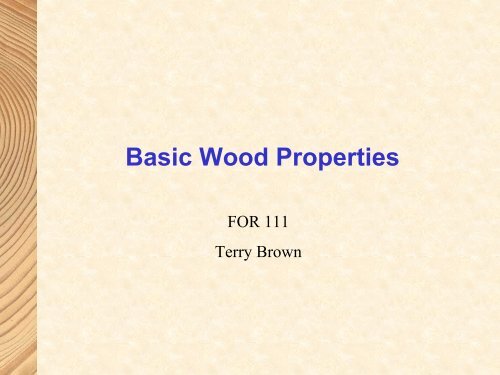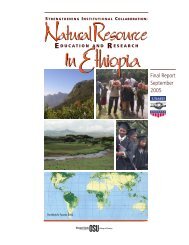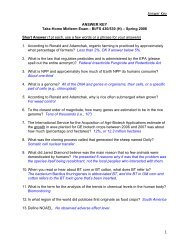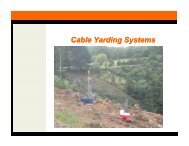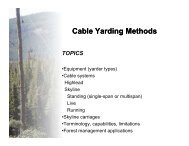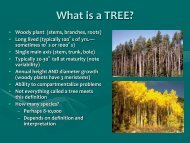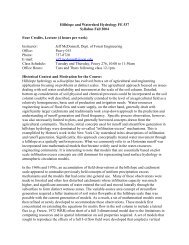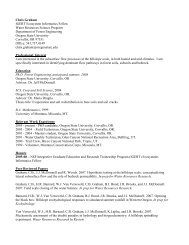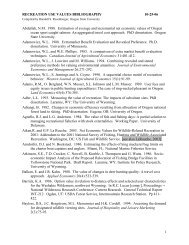Basic Wood Properties
Basic Wood Properties
Basic Wood Properties
Create successful ePaper yourself
Turn your PDF publications into a flip-book with our unique Google optimized e-Paper software.
<strong>Basic</strong> <strong>Wood</strong> <strong>Properties</strong><br />
FOR 111<br />
Terry Brown
<strong>Wood</strong> and Water
<strong>Wood</strong> & Water<br />
Importance of Water in <strong>Wood</strong><br />
<strong>Wood</strong> <strong>Properties</strong> differ with Moisture<br />
Content (MC)<br />
Dimensions<br />
Strength<br />
Thermal Conductivity<br />
Decay Resistance<br />
Electrical Resistance<br />
Dielectric <strong>Properties</strong>
<strong>Wood</strong> & Water<br />
Hygroscopicity<br />
<strong>Wood</strong> is hygroscopic below the FSP. This means wood<br />
adsorbs and desorbs water from its environment until an<br />
equilibrium dependent on ambient temperature and<br />
humidity is reached.<br />
Water Vapor or Liquid<br />
Water Vapor
<strong>Wood</strong> & Water<br />
<strong>Wood</strong> Moisture Measurement<br />
The Oven Dry (OD) basis for<br />
calculating moisture content is used<br />
with lumber, plywood, particleboard<br />
and other composite products
<strong>Wood</strong> & Water<br />
<strong>Wood</strong> Moisture Measurement<br />
Oven dry (OD) basis calculations<br />
MC<br />
=<br />
Wet<br />
wt.<br />
− OD<br />
OD wt.<br />
wt.<br />
× 100%
<strong>Wood</strong> & Water<br />
Location of Water in <strong>Wood</strong><br />
Occurs in two locations<br />
Within cell lumen<br />
Liquid or vapor<br />
Called Free Water<br />
Within the cell wall<br />
Captured in cell wall matrix<br />
Called Bound Water<br />
Water Vapor<br />
Free Water<br />
Cell Wall with<br />
Bound Water
<strong>Wood</strong> & Water<br />
Fiber Saturation Point<br />
The Fiber Saturation Point (FSP) is the point at<br />
which there is no free water present in the cell<br />
lumens and there is the maximum amount of<br />
bound water present in the cell walls<br />
Water Vapor only<br />
Cell wall saturated<br />
with Bound Water
30% Equilibrium Moisture Content
<strong>Wood</strong> & Water<br />
Equilibrium Moisture Content<br />
The Equilibrium Moisture Content (EMC) is the<br />
MC of wood when it is in equilibrium with its<br />
environment’s temperature and humidity.
6 % Equilibrium Moisture Content
12 % Equilibrium Moisture Content
<strong>Wood</strong> & Water<br />
Equilibrium Moisture Content<br />
Factors that affect EMC<br />
Temperature & Humidity<br />
Temp. °F<br />
30°<br />
70°<br />
90°<br />
130°<br />
EMC of wood at various<br />
temperature and humidity values<br />
30%<br />
6.3<br />
6.2<br />
5.9<br />
5.2<br />
Relative Humidity %<br />
60%<br />
11.3<br />
11.0<br />
10.5<br />
9.4<br />
90%<br />
21.0<br />
20.5<br />
19.8<br />
18.2
<strong>Wood</strong> & Water<br />
<strong>Wood</strong> Shrinkage<br />
When does wood shrink and swell?<br />
<strong>Wood</strong> shrinks and swells only with changes in the<br />
bound water content, i.e. below the FSP. Free<br />
water content has no affect on wood dimensions.<br />
15<br />
10<br />
5<br />
0<br />
0% 15% 30% 45% 60%<br />
Moisture Content<br />
Percent<br />
Swelling
<strong>Wood</strong> & Water<br />
Anisotropic <strong>Wood</strong> Shrinkage<br />
Anisotropic shrinkage and swelling occur<br />
when the percentage change in dimension<br />
is different for the different directional axes<br />
found in wood
<strong>Wood</strong> Shrinks Unevenly
<strong>Wood</strong> & Water<br />
Anisotropic <strong>Wood</strong> Shrinkage<br />
Differences in transverse shrinkage and<br />
swelling rates can change cross-sectional<br />
shapes
Cup
End Checks
Surface Checks
Honeycomb
Collapse
<strong>Wood</strong> & Water<br />
Green Moisture Content<br />
The MC in living trees varies by species. Differences<br />
between sapwood and heartwood also exist for<br />
hardwoods and softwoods.<br />
Hardwoods exhibit no green MC pattern between<br />
heartwood and sapwood, species variation is<br />
extremely wide<br />
Softwoods commonly have a heartwood MC near the<br />
FSP which, of course, is much lower than the MC of<br />
its sapwood
Aspen<br />
<strong>Wood</strong> & Water<br />
Green Moisture Content<br />
white fir<br />
Species<br />
white ash<br />
white oak<br />
sweetgum<br />
black walnut<br />
Softwoods<br />
loblolly pine<br />
Douglas-fir<br />
ponderosa pine<br />
w. red cedar<br />
Moisture Content<br />
Hardwoods Heartwood Sapwood<br />
46<br />
64<br />
79<br />
90<br />
95<br />
Heartwood<br />
33<br />
37<br />
40<br />
58<br />
98<br />
44<br />
78<br />
137<br />
73<br />
113<br />
Sapwood<br />
110<br />
115<br />
148<br />
249<br />
160
<strong>Wood</strong> Density
<strong>Wood</strong> Density<br />
Density Defined<br />
Density is a substance’s mass per unit<br />
volume
<strong>Wood</strong> Density<br />
Density and MC<br />
<strong>Wood</strong> density varies with moisture content<br />
because MC can affect both mass and volume<br />
To be meaningful, the MC during both mass and<br />
volume measurements must be specified.<br />
MC varies MC varies
<strong>Wood</strong> Density<br />
Density and MC<br />
Possible densities for an eighteen foot 2x4<br />
(lbs./ft 3 )<br />
Weight Basis<br />
Green<br />
(38 lbs.)<br />
Kiln-dry 15%<br />
(22 lbs.)<br />
Oven-dry<br />
(19 lbs.)<br />
Green<br />
(0.78ft 3 )<br />
48.7<br />
28.2<br />
24.4<br />
Volume Basis<br />
Oven-dry<br />
(0.68ft 3 )<br />
55.9<br />
32.4<br />
27.9
<strong>Wood</strong> Density<br />
Specific Gravity<br />
Specific Gravity (SG) is the density of a<br />
substance relative to the density of water and<br />
is sometimes called relative density or basic<br />
density<br />
Substances with a SG of less than one will<br />
float
<strong>Wood</strong> Density<br />
Specific Gravity<br />
The specific gravity of wood is always<br />
calculated using its oven-dry mass.<br />
Therefore, only the MC during volume<br />
measurement will affect specific gravity<br />
results.<br />
MC oven-dry MC varies
<strong>Wood</strong> Density<br />
<strong>Wood</strong> Porosity<br />
<strong>Wood</strong> is a mixture of void volume and cell<br />
walls. Void volume directly relates to density<br />
because cell-wall specific gravity is constant.<br />
Water<br />
Material<br />
Cell Wall<br />
Moist Air<br />
* Constant for all species<br />
Density<br />
(lbs./ft 3 )<br />
93.6*<br />
62.4<br />
0.075<br />
Specific<br />
Gravity<br />
1.5*<br />
1.0<br />
0.0012
<strong>Wood</strong> Density<br />
<strong>Wood</strong> Porosity<br />
<strong>Wood</strong> density varies among species<br />
because different cell types and sizes<br />
occur in differing proportions.
<strong>Wood</strong> Density<br />
Extractives<br />
<strong>Wood</strong> often contains organic compounds<br />
such as resins, oils, and polyphenols; and<br />
inorganic compounds such as silicates,<br />
carbonates, and phosphates.<br />
Often found in cell walls<br />
Increases overall density<br />
More found in heartwood, so its density tends<br />
to be slightly higher
Hardwoods<br />
<strong>Wood</strong> Density<br />
Growth Rate<br />
Only affects ring porous species<br />
where wide growth rings produce<br />
significant increases in latewood and,<br />
therefore, density.
<strong>Wood</strong> Density<br />
Growth Rate<br />
Softwoods<br />
Species with wide latewood bands are<br />
more dense than those without, but such<br />
species do not produce proportionally<br />
more latewood with faster growth.
<strong>Wood</strong> Density<br />
Density Variability<br />
The factors that are known to affect wood<br />
density within a species.<br />
Location within the tree<br />
Location in its range<br />
Site conditions<br />
Genetic factors
ponderosa pine<br />
red oak<br />
white ash<br />
Species<br />
Softwoods<br />
Douglas-fir<br />
loblolly pine<br />
w. white pine<br />
Hardwoods<br />
black walnut<br />
sugar maple<br />
<strong>Wood</strong> Density<br />
Density Variability<br />
Avg. green SG<br />
0.45<br />
0.47<br />
0.38<br />
0.35<br />
Avg. green SG<br />
0.51<br />
0.56<br />
0.56<br />
0.60<br />
Normal SG range<br />
0.36-0.54<br />
0.38-0.56<br />
0.31-0.45<br />
0.28-0.42<br />
Normal SG range<br />
0.41-0.61<br />
0.45-0.67<br />
0.45-0.67<br />
0.48-0.72
Mechanical <strong>Properties</strong>
Mechanical <strong>Properties</strong><br />
Mechanical or strength properties<br />
have far-ranging impacts on the use<br />
of wood in many applications<br />
<strong>Wood</strong>, like steel or concrete, is<br />
engineered and products designed<br />
based on these mechanical<br />
properties
Mechanical <strong>Properties</strong><br />
Factors Affecting Strength<br />
Anisotropic nature of<br />
wood<br />
Longitudinal properties<br />
are much different than<br />
transverse properties<br />
Radial and tangential<br />
properties generally do<br />
not differ greatly<br />
Parallel to<br />
the grain<br />
Radial<br />
Direction<br />
Tangential<br />
Direction
Mechanical <strong>Properties</strong><br />
Factors Affecting Strength<br />
Anisotropic behavior<br />
results in dramatically<br />
different load carrying<br />
capacities
Strength Measurements<br />
MOR – modulus of rupture<br />
Measures the ultimate strength of wood<br />
May be in bending, tension, or compression<br />
MOE – modulus of elasticity<br />
Measures the bending strength of wood
Mechanical <strong>Properties</strong><br />
Factors Affecting Strength<br />
Specific Gravity<br />
The most important predictor of wood strength is<br />
specific gravity<br />
Some property relationships are nearly linear and<br />
others are exponential<br />
15000<br />
10000<br />
psi<br />
5000<br />
0<br />
Bending MOR<br />
0 0.1 0.2 0.3 0.4 0.5 0.6<br />
Specific Gravity
Mechanical <strong>Properties</strong><br />
Factors Affecting Strength<br />
Defects that disturb fiber continuity and<br />
direction, most notably knots, adversely<br />
affect the strength of individual pieces.<br />
A 2” knot on the edge of a 2 X 8<br />
reduces its strength by 43% .<br />
A 2” knot in the center of a 2 X 8<br />
reduces its strength by only 24% .
Mechanical <strong>Properties</strong><br />
Factors Affecting Strength<br />
Environmental Factors<br />
Moisture Content<br />
Mechanical properties increase in value below<br />
the FSP<br />
The relationships are exponential
Mechanical <strong>Properties</strong><br />
Factors Affecting Strength<br />
Environmental Factors – continued<br />
Time<br />
Creep – added deflection occurring over time<br />
under constant load. It is accelerated by high MC<br />
and cycling.
Mechanical <strong>Properties</strong><br />
Factors Affecting Strength<br />
Environmental Factors – continued<br />
Cyclic loading or Fatigue – failure after<br />
repeated cycles of loading and unloading. For<br />
example, clear straight grained wood will<br />
retain only 60% of its original strength after 2<br />
million cycles. (Ag. Handbook #72 – <strong>Wood</strong><br />
handbook, 1974)
Mechanical <strong>Properties</strong><br />
Factors Affecting Strength<br />
Environmental Factors – continued<br />
Temperature – <strong>Wood</strong> weakens with increased<br />
temperature, especially above 100°C. The<br />
damage is accumulative. <strong>Wood</strong> is generally<br />
stronger at lower temperatures.
Mechanical <strong>Properties</strong><br />
Factors Affecting Strength<br />
Environmental Factors – continued<br />
Chemical exposure – <strong>Wood</strong> strength decreases<br />
with exposure to severe acidic or alkaline<br />
environments, but it is more resistant than steel<br />
to acidic conditions. Less permeable woods are<br />
more resistant.
Mechanical <strong>Properties</strong><br />
Factors Affecting Strength<br />
Environmental Factors – continued<br />
Biological activity – <strong>Wood</strong> strength decreases<br />
with only small weight losses due to fungal<br />
decay. Impact strength is affected more rapidly<br />
than static strength. Failure mode is brash.
Mechanical <strong>Properties</strong><br />
Lumber Strength Evaluation<br />
Grading Methods<br />
There are two methods currently in use for<br />
grading lumber and veneer<br />
Visual grading<br />
MSR – machine stress rating<br />
Grading of lumber and veneer (plywood)<br />
determines the load carrying capacity of the<br />
products<br />
This information is used to design wood<br />
structures
What’s Next?<br />
We have looked at the basic wood<br />
science aspect of wood<br />
We have looked at basic physical<br />
properties of wood<br />
Next we will look at the products and<br />
processes that are made from wood
The End


